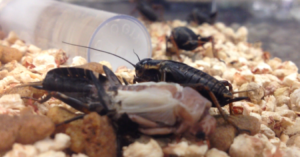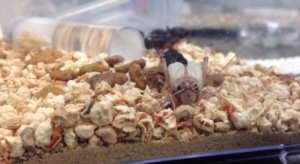Yesterday, I went into the cricket room like I normally do to check on my crickets and switch out their boxes for the anthropogenic noise behavior experiment. I didn’t expect to see anything special or out of the ordinary happen with the crickets-except maybe the terrifying amount we now have-but I was in for a surprise during my husbandry routine.
After working with crickets for months, I honestly felt like I had seen everything I would ever have seen happen to a cricket, from a cricket missing a leg leap halfway across the room to a half-molted cricket being devoured by its brothers and sisters. Keeping that in mind while performing the same routine I had repeated for months on end, husbandry had become monotone in a way. There would be days where I would feel like a machine on an assembly line as I passed through each box, replaced and adding in what was necessary for the week to come.
But as I was moving to the second box of crickets, something caught my eye. For part of the experiment, I document the date that the crickets go through their last molt and gain their wings as they reach adulthood. Every now and then I would come across a freshly molted cricket and see its bright white wings and pale brown shell compared to brown-black crickets residing around it. But this time, I saw both in one, wiggling, squirming very slowly. It took me awhile to realize what it was, but I was witnessing a cricket going through its last molt before becoming an adult.

Immediately I pulled my phone out to try to capture pictures of the scene. It was about halfway through its molt when I found it. Head down, it looked like it was struggling to get through that last half of its molt. If not done right, many crickets can lose wings or even legs during this process, impeding their life. Honestly, I thought it was stuck and she was going to be mess up the molting. But nonetheless, she was a trooper and soon pulled through fully emerged 3 minutes later. Once she was done, it she seemed to stare at me for some time, fluttering around like she was proud of what she did before she continued on with the other crickets. Overall, I just found the whole thing to be really interesting and cool.

The main reason I’m writing about all of this is that I just felt like it’s nice to take a step back from data collection and analysis and actually see what’s happening. I could’ve easily just as well continued on with the husbandry and finished up like a robot over being interested in a process I’ve only ever documented and never witnessed. I guess what I am trying to get at is that while it’s fine to focus on your work, it’s even better to find things to enjoy and be interested in. Hopefully I can keep this in mind during the rest of my experiment.
Thanks for reading my rambling!
– George El-Amir, undergraduate researcher